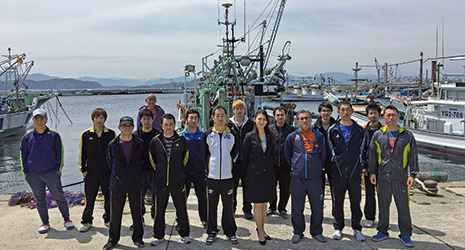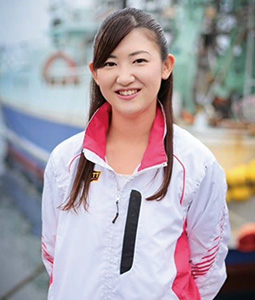Home > Highlighting JAPAN > Highlighting Japan December 2017 > Where Women Shine
Highlighting JAPAN


“Island of Fishermen” Welcomes New Captain
A new fisheries business on a small island in Yamaguchi Prefecture is winning customers nationwide under the helmswomanship of a talented local resident.
Oshima is a small island in Hagi City, Yamaguchi Prefecture with a coastline of 8.5 kilometers and a population of about 700 people. Oshima has a mild climate and bountiful sea, and is known as “an island of fishermen.” Out of about 300 households on the island, more than half are involved in the local purse seine fishing industry. However, as the fishing industry in Japan has declined, so this island too had been losing its vitality, and a sense of crisis had escalated. The local fishermen turned to Chika Tsubouchi for advice on a business development plan. Tsubouchi works as a translator and consultant after moving to Hagi after she got married.
“If the fishing industry declines on this island, the way of life on Oshima will disappear. I happened to move to Hagi after I was married, but it is the hometown of my child. I felt my lifework would be helping to sustain this traditional island with its abundant nature over the next 50 to 100 years, and I was determined to create a business plan to revitalize the local fishing industry,” says Tsubouchi, reflecting on the past.
Tsubouchi formulated the business plan with the fishermen and launched a private business, Hagi Oshima Sendan-maru (Fleet-maru), consisting of three fleets in March 2011. She was recommended by the fishermen as the representative and assumed the post, taking charge of all operations, from finding a sales route and new customers, managing products and delivery service operations, to managing three fleets. They developed the business centering on the delivery of a Fresh Fish Box, in which ikejime (a method of paralyzing fish to maintain the quality of the meat) is applied to the caught fish on their boats and packed.
At that time, Tsubouchi learned that the Ministry of Agriculture, Forestry and Fisheries had initiated the approval of a business plan based on the Act Concerning Agriculture, Forestry and Fisheries Operators’ Creation Of New Businesses Utilizing Local Resources and the Promotion of Utilization of Local Agricultural, Forestry and Fisheries Products (act for sixth industrialization / local production for local consumption). This is a measure in which the government supports initiatives for creating new business and the promotion of local agricultural, forestry and fisheries industries that utilize local resources. Tsubouchi spent about one year drawing up a business plan and applying for approval. Her plan was approved under the first (2012) “Comprehensive Business Plan.”
With this support, the private business was incorporated into GHIBLI Co., Ltd. in 2014. The company has grown since then and currently employs about sixty fishermen. The name “Ghibli” is derived from the hot, dry Saharan wind in northern Africa. Tsubouchi named the company in the hope that the fishing industry could “head out to sea with passion even in a harsh environment such as the Sahara Desert.”
Fish from Oshima have a high reputation in the restaurant trade because of the technologies and skills the company uses for delivering high quality freshly caught fish directly to the customer, including continual temperature control along a distribution route to the Tokyo area that can take as little as eight hours. The number of customers has increased from the initial zero to about 400.
The key to extreme freshness is not the delivery time, but the aforementioned ikejime. There are various kinds of ikejime for each species of fish and a high level of skill is required for the procedure. If each of the freshly caught fish is paralyzed, the blood is drained immediately and it is stored in an appropriate manner, the freshness can be maintained to the extent that the fish can be eaten as sashimi (raw fish) even one week later.
“Because of climate change and overfishing, the catch volumes of fish have been declining worldwide and it is necessary to enhance the value of fish. It should be considered as a method of resource management to take measures to prevent freshness from deteriorating, beginning with the point of production, and to prevent loss.”
The purse seine fisheries of Oshima are restricted to fishing 63 to 73 days per year to conserve resources, leaving fishermen free about 300 days per year. To increase the income of fishermen, Tsubouchi created a travel arm as a new business of GHIBLI, starting a “study tour” of Hagi Oshima Sendan-maru in 2016. Tourists can take a tour on a boat belonging to one of the Hagi Oshima Sendan-maru fleets, eat ryoshi-meshi (fishermen’s food),” and experience island life, listening to the stories of fishermen. There were no special promotions, but because Tsubouchi introduced the tour at her lecture meetings across Japan, about 400 tourists from Japan participated in one year from April 2016.
Tsubouchi now dispatches fishermen as consultants for the deployment of the business model of Hagi Oshima Sendan-maru’s fresh fish distribution.
“There are only two merchant stores in Oshima. The population has been steadily declining. However, if this island becomes revived and presents a new business model, it will empower other regions where vitality is being lost due in part to the declining birthrate and growing the aging population, as well as disasters.” This belief motivates Tsubouchi.
Sixty fishermen now head out to sea with renewed passion under the flag of Hagi Oshima Sendan-maru. Their captain is a woman whom the fishermen themselves singled out for help. Their combined efforts showcase a solution for the revitalization of local areas.
© 2009 Cabinet Office, Government of Japan







